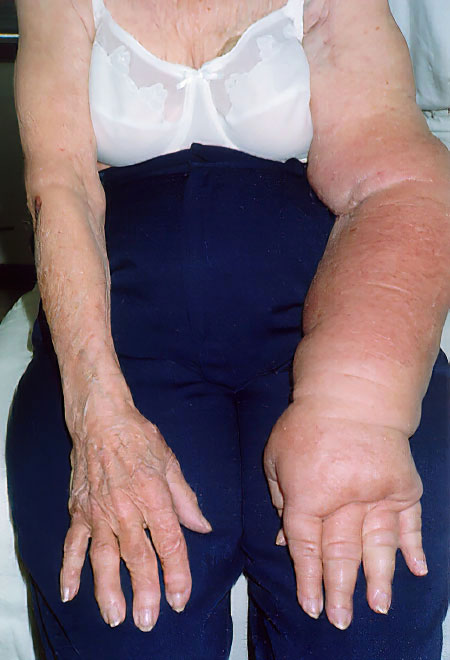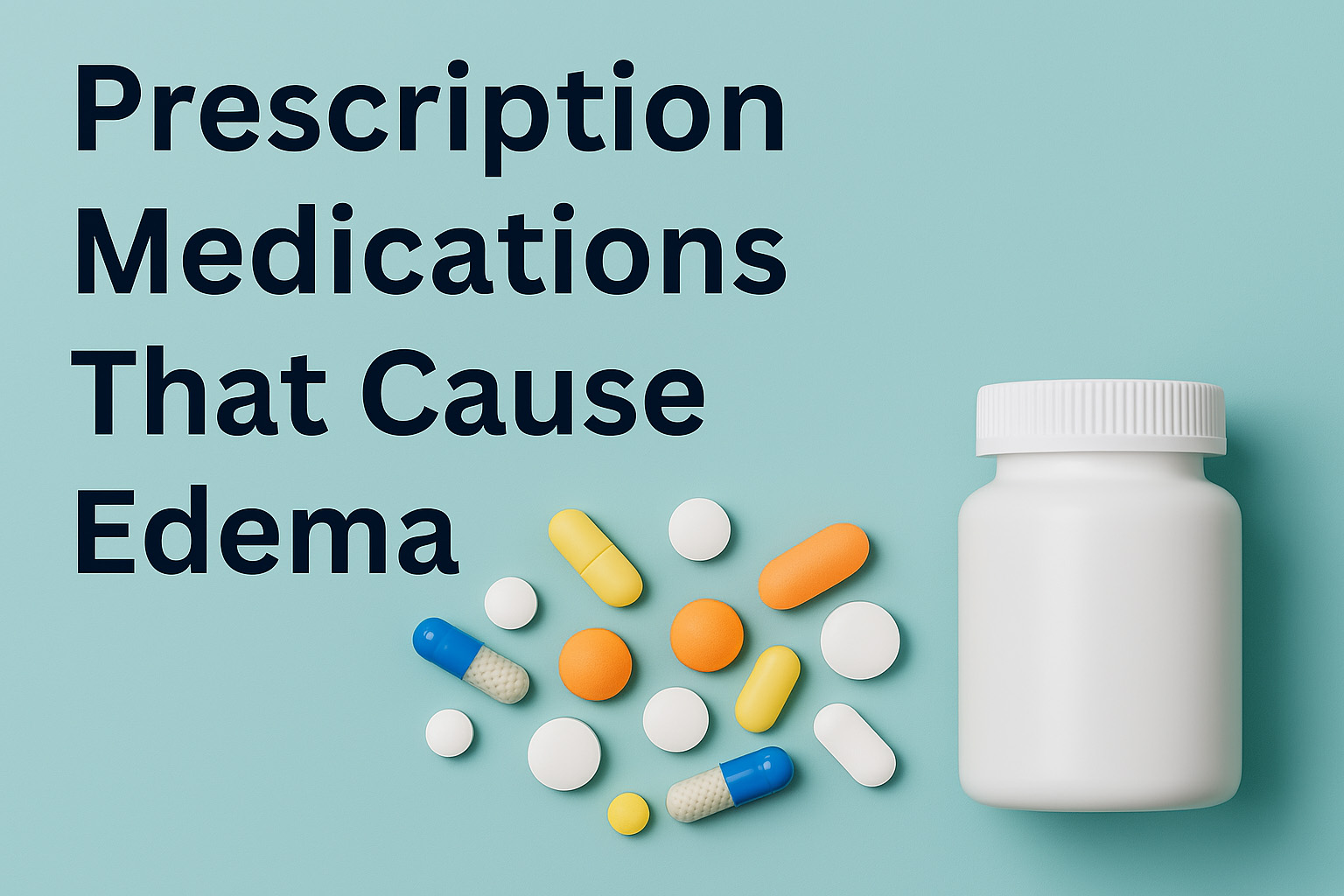Edema—defined as swelling caused by fluid accumulation in the body’s tissues—is a common side effect of many prescription medications. Although typically most visible in the lower extremities such as the legs, ankles, and feet, edema can affect any part of the body, including the face, hands, and abdomen. For individuals with lymphedema, this additional fluid retention can complicate management and potentially worsen symptoms.
Understanding which medications can cause edema, how they do so, and what to do about it is essential for both patients and healthcare providers. This article explores the most common classes of prescription drugs associated with edema, their mechanisms of action, and how to approach this side effect responsibly.
What Is Edema?
Edema occurs when excess fluid becomes trapped in the body’s tissues. It can be a temporary response to an injury or inflammation, or a chronic condition linked to underlying health issues such as heart, kidney, or liver disease.
When it comes to medications, edema may result from a variety of mechanisms, including:
- Effects on the lymphatic or venous systems
- Increased blood vessel permeability
- Sodium and water retention
- Hormonal imbalances

Recognizing medication-induced edema is crucial—especially when it contributes to worsening conditions like lymphedema or congestive heart failure.
Medications Commonly Associated with Edema
1. Calcium Channel Blockers (CCBs)
Calcium Channel Blockers are frequently prescribed for high blood pressure and certain cardiac conditions. Drugs in this category include:
- Amlodipine
- Nifedipine
- Verapamil
These medications lower blood pressure by relaxing and widening blood vessels (vasodilation). However, this vasodilation can also allow fluid to leak into nearby tissues, particularly in the lower legs and ankles.
Key Points:
- Edema is dose-dependent.
- Swelling usually resolves when the dosage is adjusted or the medication is discontinued.
- Often mistaken for weight gain or heart failure.
Clinical Insight: Edema from CCBs is often more pronounced in older adults and is reversible when managed correctly (Messerli et al., 2002).
2. Nonsteroidal Anti-inflammatory Drugs (NSAIDs)
NSAIDs are widely used for pain and inflammation. Common examples include:
- Ibuprofen
- Naproxen
NSAIDs can cause sodium and water retention by inhibiting prostaglandins—hormone-like substances that help regulate kidney function. In individuals with underlying kidney or heart issues, this fluid retention can quickly result in edema.
Key Points:
- Chronic use increases the risk.
- Edema often affects the lower extremities.
- Can exacerbate heart and kidney conditions.
Note: If you’re taking NSAIDs regularly and notice swelling, consult your healthcare provider to explore alternative pain relief strategies.
3. Corticosteroids
Corticosteroids, such as prednisone and dexamethasone, are potent anti-inflammatory medications used in autoimmune disorders, asthma, and allergic reactions.
These drugs mimic the effects of aldosterone—a hormone that promotes sodium retention and potassium excretion. As a result, fluid builds up, leading to puffiness or generalized swelling.
Key Points:
- Edema may appear as facial puffiness (moon face) or general bloating.
- Long-term use may also contribute to weight gain and high blood pressure.
4. Hormonal Medications
Medications containing estrogen or progesterone—such as oral contraceptives or hormone replacement therapy—can also lead to fluid retention.
Estrogens stimulate the production of angiotensin and aldosterone, two hormones responsible for sodium retention. This hormonal shift promotes water accumulation, especially in individuals already prone to swelling.
Key Points:
- Swelling may increase during menstrual cycles.
- Edema is more likely with higher estrogen doses.
Tip: Low-dose or non-estrogen contraceptive options may be considered in consultation with a healthcare provider.
5. Antidepressants
Certain antidepressants, particularly Selective Serotonin Reuptake Inhibitors (SSRIs) and Monoamine Oxidase Inhibitors (MAOIs), have been reported to cause edema in some patients.
Though the exact mechanism is unclear, it may involve changes in the autonomic nervous system or vascular permeability.
Common Medications:
- Fluoxetine (Prozac)
- Paroxetine (Paxil)
- Phenelzine (Nardil)
Key Points:
- Edema is usually mild but should be monitored.
- May resolve with dosage adjustment or alternative therapy.
6. Diabetes Medications (Thiazolidinediones)
Medications like pioglitazone and rosiglitazone, used to treat type 2 diabetes, improve insulin sensitivity but often cause fluid retention.
In patients with existing heart issues, these drugs can worsen or even trigger congestive heart failure.
Key Points:
- Monitor for weight gain and swelling, especially in the feet and ankles.
- Discuss alternatives if symptoms persist.
Clinical Guidance: The FDA has issued warnings regarding the use of thiazolidinediones in patients with pre-existing cardiac conditions (FDA Safety Alerts).
Special Considerations for Lymphedema Patients
For individuals managing lymphedema, the introduction of a medication known to cause edema can pose additional challenges. Increased fluid retention may lead to more pronounced swelling and discomfort, making standard treatment protocols less effective.
However, it’s critical to note:
Never stop or change your prescribed medication without speaking to your doctor. Sudden discontinuation can result in serious health consequences, particularly for conditions like high blood pressure, depression, or diabetes.
A collaborative approach—often involving the prescribing physician and a certified lymphedema therapist—can help balance the benefits of the medication with the need for symptom management.
Managing Medication-Induced Edema
If you experience swelling and suspect it may be linked to your medication, consider the following steps:
- Track Your Symptoms: Record when the swelling began and any patterns you notice.
- Contact Your Provider: A simple dosage adjustment or switch to a different drug class may be all that’s needed.
- Elevate Affected Limbs: Elevation can help reduce swelling in the legs and feet.
- Wear Compression Garments: Particularly beneficial for lymphedema patients, compression therapy helps support lymphatic and venous return.
- Stay Active: Low-impact exercise promotes circulation and lymphatic drainage.
Conclusion
Edema is a potential side effect of numerous prescription medications. While it can be uncomfortable and disruptive—especially for those with lymphedema—it is usually manageable. Identifying the cause and working closely with your healthcare provider ensures that both your underlying medical conditions and your edema are treated safely and effectively.
Understanding the link between edema and medications empowers you to take control of your health while minimizing discomfort. With proper care and communication, you can continue your treatment journey confidently and comfortably.
References
- Messerli, F.H., et al. (2002). “Calcium Channel Blockers and Peripheral Edema: A Class Effect?” Current Hypertension Reports.
- FDA Safety Alerts: www.fda.gov
- Mayo Clinic – Edema Overview: www.mayoclinic.org
- National Institutes of Health – PubMed: www.ncbi.nlm.nih.gov/pubmed

